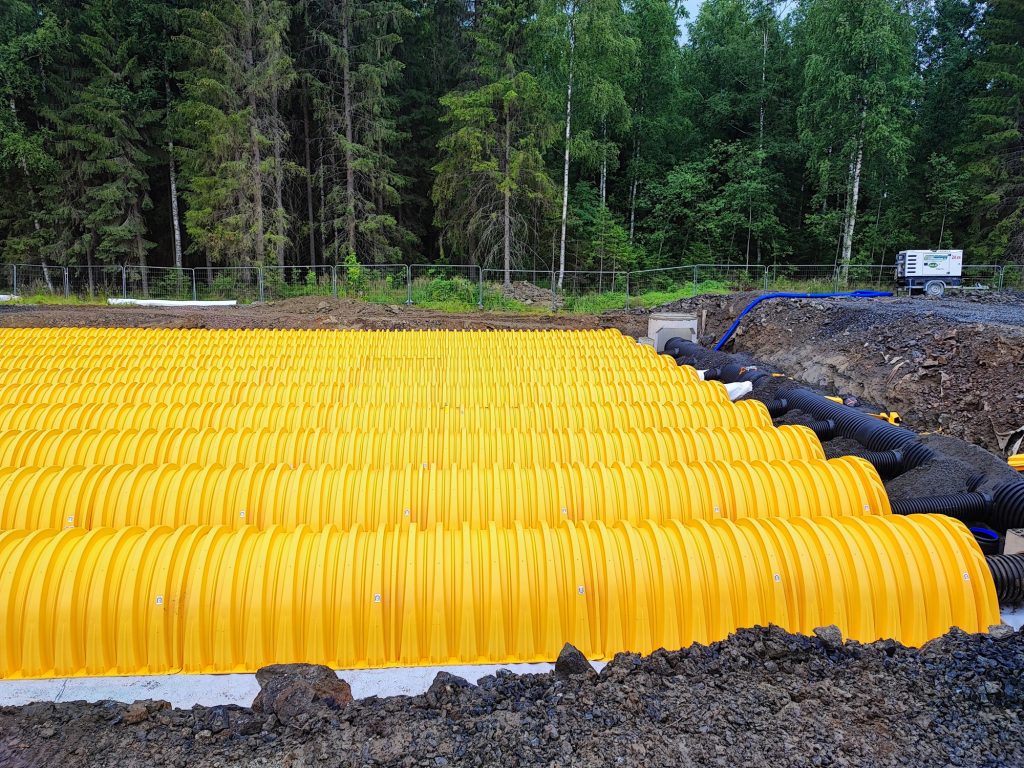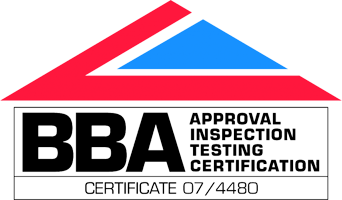Monthly Archives: August 2024
ADS extends StormTech SuDS attenuation and storm water treatment range
The new StormTech SC-800 arch-shaped chamber from Advanced Drainage Systems (ADS), a global leader in corrugated thermoplastic drainage pipes and a specialist in water management systems; not only holds more water than the company’s current best-selling and most popular chamber – the SC-740 – but also requires less embedment stone for installation, and has a reduced minimum cover depth, resulting in greater storage capacity for the same footprint area and depth, plus reduced construction time and cost.

The SC-800 maximizes storage within a compact footprint while its corrugated design pares down the minimum cover depth and provides superior structural integrity. The latest development in the company’s drive to reduce footprints sees the SC-800 with a 7% smaller footprint than the SC-740 for the same storage volume.
Unlike other below-ground SuDS attenuation systems such as crates and pipes, which allows runoff into the entire tank storage space, the StormTech arch-shaped system directs first flush flow into the patented Isolator Row – an integral water quality treatment device that has two treatment stages: sedimentation and filtration.
Isolator Row is independently tested and validated to remove more than 80% Total Suspended Solids (TSS), often avoiding the need for a costly sediment removal system upstream of the tank. Isolator Row can also remove other pollutants such as particulate-bound hydrocarbons and metals.
Another two treatment stages can take place within the embedment stone: adsorption and biodegradation, leading to even greater removal efficiencies. Isolator Row is the only part of a StormTech system that needs maintenance, as the other chambers only receive ‘clean’ untreated runoff from flows exceeding the first flush flow rate.
Cleaning is carried out at intervals of typically two to five years, depending on local conditions, using standard sewer jetting equipment and a vacuum tanker to remove the waste.
StormTech’s arch design sheds load from the chamber to the surrounding stone, which forms a structural arch that transfers loads into stone columns between the chambers and spreads the load through to the native soil, resulting in extraordinary minimum and maximum cover depths. The new SC-800 chamber has a minimum cover depth of 375mm. All StormTech standard installation details are based on HGV traffic loading.

The design of StormTech chambers means that the units can be stacked, taking up a minimum of space for transportation, storage and to speed-up installation.
By adding SC-800 into the StormTech range, ADS has enhanced design flexibility for SuDS attenuation and storm water management. This innovation exemplifies ADS’s commitment to providing cutting-edge products that meet the evolving needs of the construction industry.
For more information on Advanced Drainage Systems, visit www.adspipe.co.uk.
SuDS: when grey is good

Under the new Government, cleaning up our water courses is a priority. That means that more robust approaches to treating polluted surface water, says Stuart Crisp, UK manager of Advanced Drainage Systems (ADS).
A major source of water pollution comes from surface water runoff from our towns, cities and highways. According to the Government’s Environmental Improvement Plan 2023, polluted surface water contributes to some 18% of water bodies failing to reach a status of ‘good’ under the Water Framework Directive. Meanwhile pollution from agriculture and rural land impacts on 40% of water bodies and pollution from wastewater on 36%.
The problem with surface water is that it is not being adequately treated before it flows into streams, rivers, ponds or lakes. In many cases, that is because no pollution treatment measures have been installed. In others, it is because elements designed to remove pollution are not being adequately inspected and maintained. And in some cases, it is down to inadequate or erroneous designs.
One serious issue is the mantra ‘green is good, grey is bad’ that underpins the policies and documents of many adopting bodies and asset owners when it comes to sustainable drainage systems (SuDS). The argument is that surface water should be controlled and managed at the surface, using vegetative solutions; ‘grey’ below-ground proprietary elements must be avoided at all costs.
However, the omission of grey SuDS infrastructure as a first defence in the treatment train, where there is a medium or high risk of pollutants in the surface water, can lead to contaminants entering vegetative SuDS components. In such situations, wildlife that has been attracted to settle there may be harmed by the presence of poisonous substances and polluted discharges may enter into water bodies downstream of the system.
The CIRIA SuDS Manual C753 provides a relatively simple method for dealing with such water pollution risks. For each type of pollutant, it sets out pollution hazard indices for a range of site types. The designer must then include SuDS components in the treatment train which have combined pollution mitigation indices equal to or exceeding the pollution hazard indices.
Where there is a risk of high pollutant loads it may be necessary to go beyond the simple index approach. For heavily trafficked roads, designers must use the process set out in the Design Manual for Roads and Bridges, although there are gaps in this guidance relating to the rainfall events, maximum treatment flow rates and treatment volumes that should be applied.
Treatment flow rates
When designing SuDS treatment trains for surface water pollution, it is important to appreciate the difference between hydraulic flow rates and treatment flow rates and the impact that they have on the design and each other.
The hydraulic flow rate is the volume of water that a system can handle within a certain timeframe which is determined with reference to the maximum event it must handle. The treatment flow rate is not the same. This is because most pollutants are contained in the ‘first flush’. The first flush is the initial runoff at the beginning of a rainfall event, which carries all the pollutants that have built up over a preceding dry period.
In longer lasting events, water that follows on after the first flush is likely to carry fewer pollutants because many of them have been washed away.
There are a variety of proprietary SuDS elements that can be used to remove sediment from the first flush of surface water; while there are also some SuDS elements – such as ADS’s StormTech arch-shaped system – which combine both treatment and water attenuation.
Those designing SuDS and those advising developers and adopting bodies need to develop a better understanding of how green and grey infrastructure can be deployed together to deliver the best possible results for water quality.
It is vital that SuDS designers appreciate the interplay of hydraulic flow rates and treatment flow rates and understand the types and amount of pollutant likely to arise within the runoff.
An appropriate water quality management strategy must be deployed to capture and treat the anticipated pollutants from the development, using a suitable combination of grey and green infrastructure. Failing to do so could lead to decreased treatment efficiency and harmful pollutants finding their way into the environment plus higher maintenance costs.
For more information on Advanced Drainage Systems, visit www.adspipe.co.uk.
Water Magazine, August 2024



